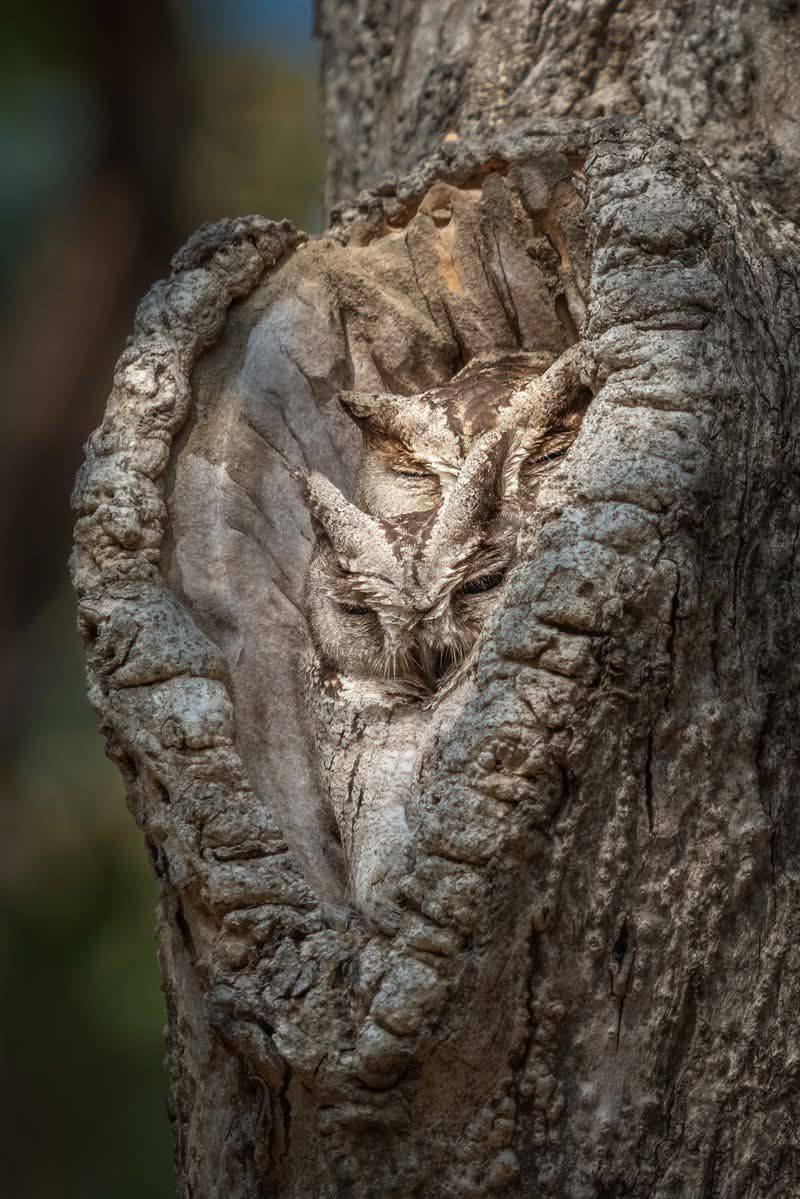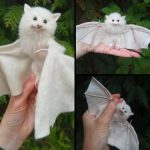Masters of Disguise: The Astonishing Camouflage of the Screech Owl

Masters of Disguise: The Astonishing Camouflage of the Screech Owl
In the vast tapestry of the natural world, some of the most fascinating stories are those that are easily overlooked—hidden in plain sight. One such marvel is captured in a breathtaking photograph by wildlife photographer Sarosh Lodhi, where an owl, almost indistinguishable from the bark of a tree, rests quietly in a natural crevice. What at first glance seems like an ordinary tree trunk reveals, upon closer inspection, a remarkable display of camouflage, instinct, and survival.
This is not just a photograph—it is a window into the incredible evolutionary adaptations of the Eastern Screech Owl, a master of concealment and quiet resilience.
A Closer Look at the Owl in the Tree
The owl nestled in the crevice of the tree is a perfect mimic of its environment. Its feathers blend seamlessly with the texture, color, and pattern of the bark. The creature’s stillness further enhances the illusion, making it nearly invisible to predators and prey alike.
This behavior is not accidental—it is the product of millions of years of natural selection. In the wild, survival often depends not just on strength or speed, but on the ability to go unnoticed. For the owl, camouflage is its shield, allowing it to live, rest, and raise its young in relative safety.

Meet the Eastern Screech Owl
The bird in the photo is most likely the Eastern Screech Owl (Megascops asio), a small owl species native to North America. Despite its name, this owl doesn’t always “screech”—its call is more of a soft, eerie trill. This nocturnal predator is known for its cryptic coloration and ability to roost in tight tree cavities, where it becomes virtually invisible during daylight hours.
Here are some quick facts about the Eastern Screech Owl:
-
Size: 6 to 10 inches tall
-
Wingspan: 18 to 24 inches
-
Lifespan: Up to 14 years in the wild
-
Habitat: Deciduous forests, wooded suburbs, and city parks
-
Diet: Insects, small mammals, birds, amphibians
Its plumage comes in two main color morphs—gray and reddish-brown—both of which are exquisitely adapted to blend in with different types of tree bark.
The Art of Camouflage
Camouflage, or cryptic coloration, is one of nature’s most effective survival strategies. For the Eastern Screech Owl, this means more than just hiding—it’s about becoming part of the landscape.
Their feathers aren’t just colored like bark; they have the texture and irregular striping that mimics the cracks and ridges of a tree trunk. The owl’s ability to press itself into the bark, close its eyes, and remain perfectly still enhances the illusion.
This camouflage serves multiple purposes:
-
Protection from predators: Larger birds like hawks and owls, as well as terrestrial predators like raccoons, pose a threat. By blending into the tree, the owl avoids detection.
-
Stealth hunting: Remaining unseen allows the owl to surprise its prey—usually mice, lizards, or insects—under the cover of night.
-
Nesting security: Camouflaged nests and chicks are less likely to be raided, increasing the chances of survival for the next generation.

Sarosh Lodhi: Capturing the Unseen
Photographer Sarosh Lodhi, known for his evocative wildlife imagery, captured this remarkable scene with precision and sensitivity. The photo not only highlights the owl’s camouflage but also invites viewers to pause and truly see what they might otherwise miss.
Lodhi’s work often focuses on bringing attention to hidden or endangered species. With this image, he turns a quiet moment in nature into a powerful story of adaptation and elegance. It reminds us that the forest is alive with invisible watchers, guardians, and survivors.
The Role of Tree Cavities in Owl Ecology
The tree cavity in which the owl is nestled plays a critical role in its life cycle. Screech owls do not build nests like many birds. Instead, they rely on natural hollows in trees, abandoned woodpecker holes, or even man-made nest boxes.
Inside these cavities, owls:
-
Roost during the day, concealed from sight
-
Raise their young, usually laying 2–6 eggs per breeding season
-
Store food, especially during harsh winters
These cavities offer warmth, protection from the elements, and safety from predators. Unfortunately, as forests are cleared and old trees are cut down, these natural shelters are becoming increasingly scarce.
The Importance of Protecting Old Trees
The survival of species like the Eastern Screech Owl is closely tied to the health of forests. Trees with natural hollows are typically older, and often the first to be removed in logging operations or urban development. This threatens not only owls but also woodpeckers, bats, bees, and other cavity-nesting creatures.
Conservationists are now encouraging practices like:
-
Preserving standing dead trees (snags) as nesting sites
-
Installing artificial nest boxes in suitable areas
-
Maintaining buffer zones around forests in urban planning
Every tree cavity is a potential home. And every home is a vital link in the web of life.
Owls and the Balance of Nature
Owls play a crucial role in the ecosystem. As apex nocturnal predators, they keep populations of rodents and insects in check, contributing to the health of crops and forests. Without them, pest populations could grow unchecked, causing damage to agriculture and spreading disease.
Here’s how owls contribute to the ecosystem:
-
Natural pest control: One owl can eat dozens of mice in a single night.
-
Indicator species: Their presence signals a healthy ecosystem.
-
Seed dispersal: Owls occasionally consume fruit and help spread seeds.
Their silent, efficient hunting style—combined with their camouflage—makes them both elusive and essential.
Seeing the Unseen: What This Photo Teaches Us
At first glance, the owl in Sarosh Lodhi’s photo seems to be just another knot in the tree. But the moment you see it, a whole world opens up. You realize how much life goes unnoticed, how much beauty hides in plain sight.
This is a lesson for more than just nature enthusiasts—it’s a reminder for all of us:
-
To slow down
-
To observe closely
-
To appreciate the quiet miracles of the world
Nature is not always loud or flashy. Sometimes, it is subtle, patient, and still—like the owl in the tree.
Final Thoughts: Guardians of the Forest
The Eastern Screech Owl may be small and silent, but it stands as a powerful symbol of the forest’s hidden strength. Camouflaged, cautious, and calm, it watches over the night, keeping balance in the ecosystem.
As human development continues to encroach upon wild spaces, images like the one captured by Sarosh Lodhi become more than just beautiful—they become vital tools of awareness and inspiration.
Let this photo not only amaze you—but move you to protect the quiet corners of the world. Because somewhere, nestled in a tree hollow, a tiny owl is watching. And it deserves a future as hidden and magical as its camouflage.











